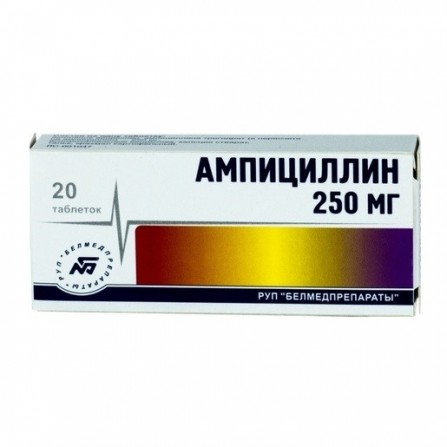Ampicillin trihydrate pills 250mg N20
Condition: New product
1000 Items
Rating:
Be the first to write a review!

More info
Description
Ampicillin - antimicrobial agent, antibiotic, semi-synthetic penicillin. Ampicillin is a semisynthetic broad-spectrum antibiotic used for diseases caused by mixed infection.
Active ingredients
Ampicillin
Composition
1 tablet contains: Active substance: etoricoxib 120 mg. Adjuvants: calcium hydrophosphate, microcrystalline cellulose, croscarmellose sodium, magnesium stearate. Composition of the shell: opadry II green 39K11529, carnauba wax. Composition of the film shell: lactose monohydrate, hypomellasis, quest paste; , aluminum varnish based on indigo carmine dye (E132), iron dye yellow oxide (E172).
Pharmacological effect
Ampicillin is an antibiotic of a group of semisynthetic penicillins with a wide spectrum of action. It has a bactericidal effect due to the suppression of the synthesis of the bacterial cell wall. It is active against gram-positive aerobic bacteria: Staphylococcus spp. (with the exception of strains producing penicillinase), Streptococcus spp. (including Enterococcus spp.), Listeria monocytogenes, Gram-negative aerobic bacteria: Neisseria gonorrhoeae, Neisseria meningitidis, Escherichia coli, Shigella spp., Salmonella spp., Bordetella pertussis, some strains of Haemophilus-influenzaeraemia, anemosis, anemosis, anemosis, antiedema, spp. Acid-resistant.
Pharmacokinetics
In the gastrointestinal tract absorbed 40-60% of the dose. The maximum concentration in the blood is reached in 1.5-2 hours after administration. Penetrates tissue and body fluids. Not destroyed in the acidic environment of the stomach. Excreted mainly by the kidneys in unchanged form. High concentrations of unchanged antibiotic are created in the urine. Partially excreted in the bile, in nursing mothers - with milk. With repeated injections, it does not accumulate, which makes it possible to use ampicillin trihydrate for a long time.
Indications
Infectious and inflammatory diseases caused by microorganisms sensitive to ampicillin, including: - respiratory tract infections (including bronchitis, pneumonia, lung abscess), - upper respiratory tract infections (including tonsillitis), - biliary tract infections (including cholecystitis, cholangitis), - urinary tract infections (including pyelitis, pyelonephritis, cystitis), - gastrointestinal infections (including salmonellosis), gynecological infections, - skin infections and soft tissues, - peritonitis, - sepsis, septic endocarditis, - meningitis, - rheumatism, - erysipelas, - scarlet and, - gonorrhea.
Contraindications
- hypersensitivity to antibiotics from the penicillin group and other beta-lactam antibiotics, - pronounced abnormal liver function (for parenteral use).
Use during pregnancy and lactation
It is possible to use the drug during pregnancy according to indications in cases where the benefit to the mother outweighs the potential risk to the fetus. Ampicillin is excreted in breast milk at low concentrations. If necessary, the use of the drug during lactation should decide on the termination of breastfeeding.
Dosage and administration
Set individually depending on the severity of the disease, the localization of the infection and sensitivity of the pathogen. When administered orally, the single dose for adults is 250-500 mg, the daily dose is 1-3 g. The maximum daily dose is 4 g. For children, the drug is prescribed in a daily dose of 50 - 100 mg / kg, for children with body weight up to 20 kg - 12.5-25 mg / kg. The daily dose is divided into 4 doses. The duration of treatment depends on the severity of the infection and the effectiveness of the treatment. Tablets are ingested regardless of the meal.
Side effects
Allergic reactions: skin rash, urticaria, angioedema, pruritus, exfoliative dermatitis, erythema multiforme, in rare cases - anaphylactic shock. On the digestive system: nausea, vomiting, diarrhea, glossitis, stomatitis, pseudomembranous colitis, heart block, transaminase. From the hematopoietic system: anemia, leukopenia, thrombocytopenia, agranulocytosis. Effects due to chemotherapeutic action: oral candidiasis, vaginal candidiasis.
Overdose
Manifested toxic effects on the central nervous system (especially in patients with renal insufficiency). Treatment: symptomatic.
Interaction with other drugs
Probenecid with simultaneous use with ampicillin reduces the tubular secretion of ampicillin, resulting in an increase in its concentration in the blood plasma and increases the risk of toxic action. With simultaneous use of Ampicillin with allopurinol, the likelihood of skin rash increases. simultaneous use with ampicillin increases the effectiveness of anticoagulants and aminoglycically antibiotics zid.
special instructions
With caution and against the background of the simultaneous use of desensitizing agents, the drug should be prescribed for bronchial asthma, hay fever and other allergic diseases. In the process of using Ampicillin, systematic monitoring of the function of the kidneys, liver and peripheral blood picture is necessary. .Patients with impaired renal function require correction of the dosage regimen depending on QC. When using the drug in high doses In patients with renal insufficiency, a toxic effect on the CNS is possible. When using a drug for treating sepsis, bacteriolysis reaction is possible (Yarish-Herxheimer reaction). drug may develop superinfection caused by ampicillin-resistant microorganisms. For the prevention of the development of candidiasis at the same time as Ampicillin trace assign a levorin or nystatin, as well as vitamins B and C.


